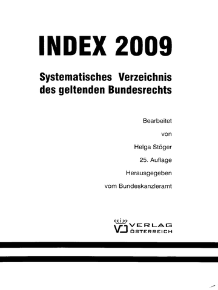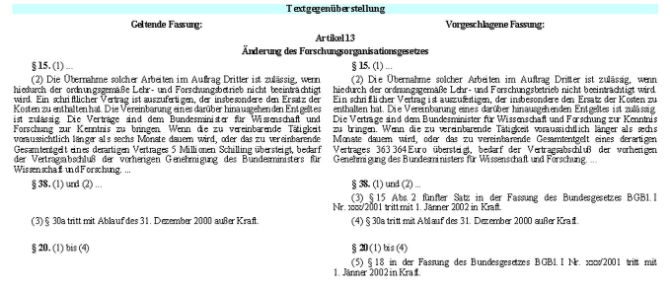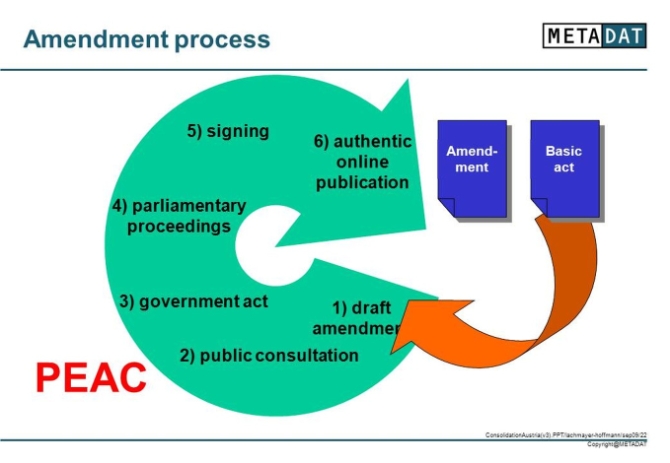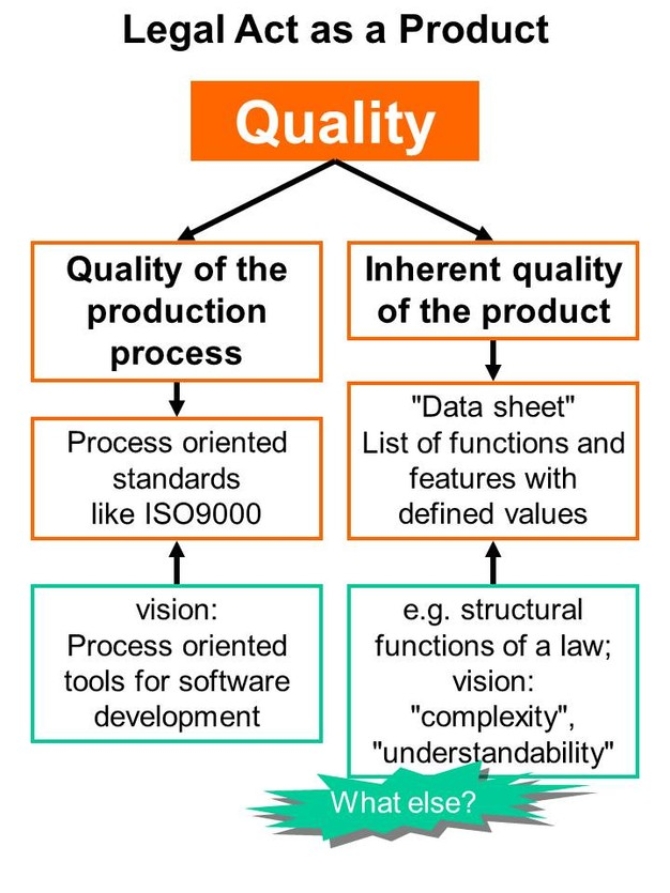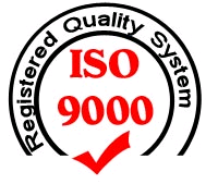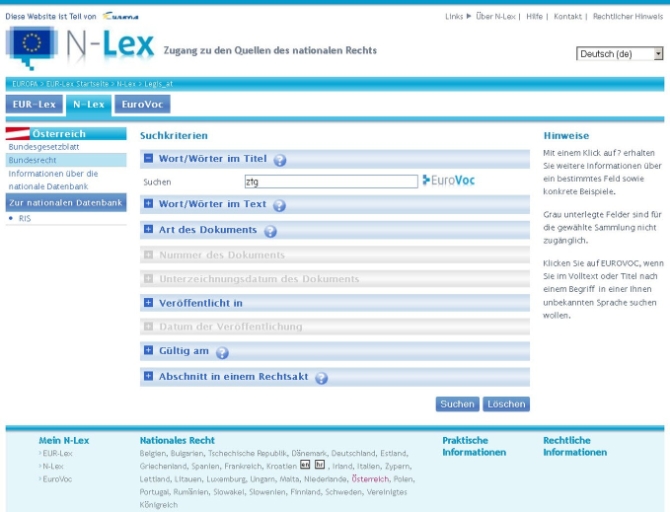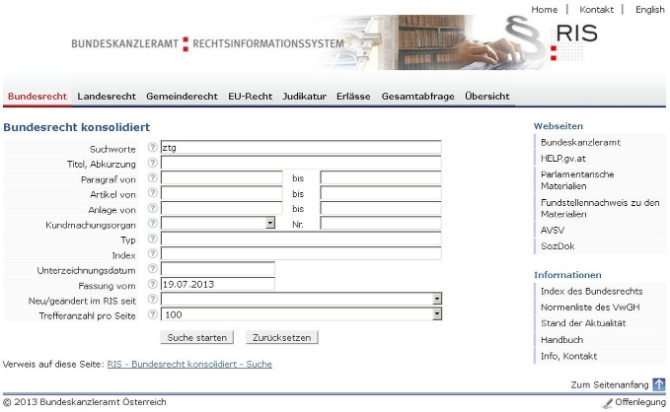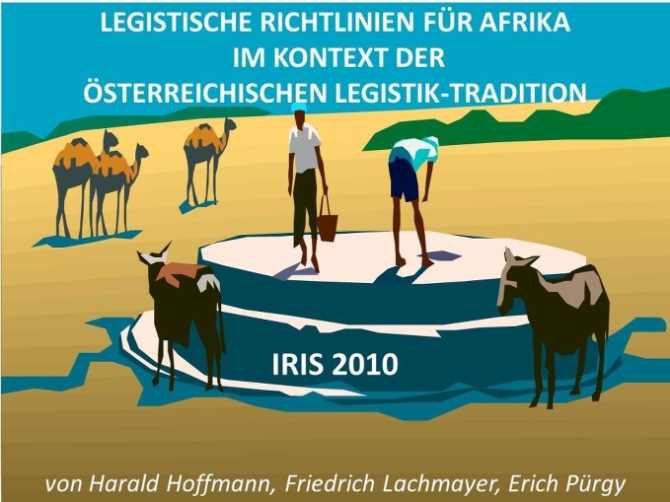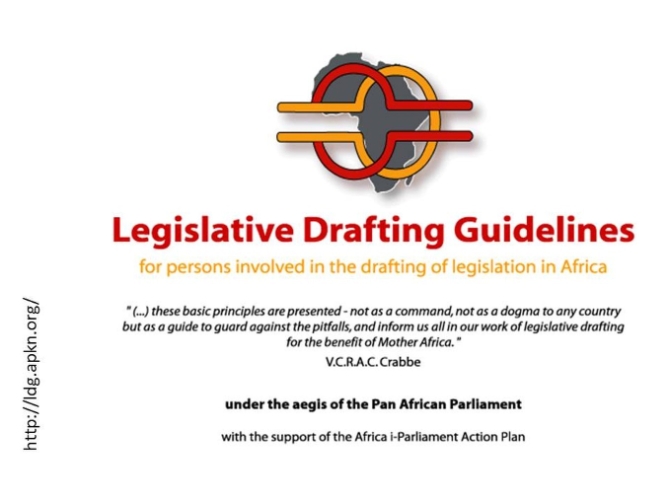1.
Glossary of terms and abbreviations ^
| Term | Explanation |
| ASCII | American National Standard Code for Information Interchange («pure text») |
| Austrian Portal Network | à PV |
| BKA | Bundeskanzleramt (Federal Chancellery) |
| CEN | Comité Européen de Normalisation |
| CHLexML | XML Schema for legislative data at federal, cantonal and municipal level |
| CPL | Callable Personal Librarian. In essence, a search engine: «The most reliable and scalable text engine available to manage full text, structured data, hypertext, forms-based searching and multimedia applications». |
| ELI | European Legislation Identifier |
| EnAct | Name of the legislation system of Tasmania (Australia) |
| HTTP | HyperText Transfer Protocol |
| IOP-Gateway | InterOperability gateway, a specific gateway developed in the R4eGov Project for connecting «e-Administration in the large», as required by the Project |
| JASPI | Jednotný automatizovaný systém právnych informácií (integrated automated legal information system of Slovakia) |
| KAV | Kompetenzzentrum für Amtliche Veröffentlichungen (Official Publications Centre, OPC) of the Swiss Federal Chancellery |
| OE | Ontology Explorer, a tool developed in the R4eGov Project. It allows for the automatic generation of the XML schema out of an ontology, e.g. the ontology used for queries. |
| OeSD | Österreichische Staatsdruckerei (Austrian State Printing House); remaining operations privatised 2000 as a consequence of electronic publishing of legal information in RIS. |
| OPC | à KAV |
| PEAK | Permanente Elektronische Authentische Konsolidierung (Permanent Electronic Authentic Consolidation) |
| Pilot | In the BKA environment, synonymously used to the Demonstrator (RIS-v3); term used only in some of the original Project texts and work package titles |
| PKI | Public Key Infrastructure |
| Project | The R4eGov Project |
| PV | Portalverbund (Austrian Portal Network). Secure Austrian Interconnect facility for governmental resources allowing e.g. for Single-Sign-On with separation of user management and resource management. |
| R4eGov | Research for e-Government |
| RDB | Relational Data Base |
| RIS | Rechtsinformationssystem (Legal Information System) |
| RIS Demonstrator | The Demonstrator built in the R4eGov Project. In essence, it was RIS-v3 plus the software needed for a proof-of-concept and a PV interface. Regarding R4eGov the IOP-Gateway software functionality was the important part. Regarding BKA’s RIS environment the SR software functionality was more important. |
| RIS-v1 | ASCII based RIS |
| RIS-v2 | XML based RIS, current production system |
| RIS-v3 | advanced XML based RIS, demonstration system, result of the R4eGov Project |
| SAML | Security Assertion Markup Language |
| SOAP | Simple Object Access Protocol |
| SR | Semantic Repository, a specific database developed in the R4eGov Project. A hierarchical native XML database allowing for «semantic references». |
| UBAS | Unabhängiger Bundesasylsenat (Independent Federal Asylum Board), predecessor of the Asylum Court. |
| UN/DESA | United Nations Department of Economic and Social Affairs |
| XML | eXtensible Markup Language |
2.
Introduction ^

- Fig. 1 R4eGov logo
Project Title: Towards e-Administration in the largeProject Acronym: R4eGov («Research for e-Government»)Start date: 1st March 2006End date: 28th February 2009 http://cordis.europa.eu/projects/index.cfm?fuseaction=
app.details&TXT=r4egov&FRM=1&STP=10&
SIC=&PGA=&CCY=&PCY=&SRC= &LNG=en&REF=79308
Fig. 1 R4eGov logo
- To gather and elicit the requirements for e-Administration in the large, on basis of which a concrete interoperation of web service enabled legacy public sector applications was to be achieved using collaborative work flows.
- To provide the tools and methods for an e-Administration in the large from a technical and sociological perspective.
- To provide the required security and privacy for an e-Administration in the large, defining the appropriate methods and tools for control, security and privacy at the collaborative work flow and application layer.
- an «InterOperability Gateway (IOP-Gateway)» handling the interoperability requirements of the Project («e-Administrations in the large»), e.g. to automatically and securely exchange data between the work flow systems of administrations, allowing them to use their own (inherently incompatible) legacy and work flow systems and to apply even different security policies.
- a «Semantic Repository (SR)», which is a novel database engine (based on a native XML database) combined with an innovative search engine allowing for a «semantic search».
- an «Ontology Explorer (OE)», a tool which allows for the mapping of the ontology of legal information (queries for information retrieval in particular) to the XML schema (in the sense of the database structure), largely simplifying database design and management.
The work on R4eGov focuses on the following:
- an XML version of RIS (RIS-v2), offering an enhanced user interface. RIS-v2 became the RIS «production system» which still is in use today.
- a prototype of a version of RIS with enhanced capabilities (RIS-v3, fully operational for some time after R4eGov ended). It uses the SR and a specific version of the IOP-Gateway allowing for:
- innovative end-to-end-security for the handling of RIS documents with sensitive information (e.g. personal data)
- Austrian Portal Network access to RIS, allowing for well-defined input to (e.g. for publishing) and output from RIS (e.g. for publishers adding value to RIS contents).
- all the other enhanced capabilities listed in à clause 5 (Achievements) and in à clause 6 (Future potential of current deployment).
This paper is largely based on the R4eGov deliverable «Consolidation of pilot results, summary of lessons learnt, and the preservation of setups and information» [1].
3.1.
The old days ^
The transition from a print to an electronic version started in 1972 with a trial project on constitutional law, carried out by BKA in co-operation with IBM Austria. Although this trial ended already in 1973 it became one starting point for BKA with RIS 10 years later.
Another starting point was the index of Austrian federal law. In the mid 80ies the Constitutional Service of BKA started to create this index, to be printed by OeSD. RIS initially was a by-product of the printed version of this index, which has been issued annually since then (à Fig. 2). RIS was a by-product as well for publishing electronic files of their printed counterparts (laws published in the Law Gazette). With time, RIS became a product by itself. This transition period lasted 15 years.
3.2.
Authentic publication ^
3.3.
Categories ^
On 6th June 2005, as a contribution to the LOAIT workshop organised within the ICAIL conference in Bologna [2], Harald Hoffmann and Friedrich Lachmayer presented the mapping of categories into the world of legal ontologies. This mapping now partially is used with Ontology Explorer (OE), developed as part of RIS-v3 in the Project.
4.1.
Reasons to join the R4eGov Project ^
- The user interface for the retrieval of documents was outdated (e.g. pure ASCII text);
- The documents were coded in a proprietarily structured ASCII format, similar to XML which became a standard later
- The CPL search engine was discontinued
- Security was marginal, differentiating between Internet and Intranet users only;
- Publication of documents was a rather manual process, as was the export of data for value added resellers of legislative information.
- An organisation producing legislative information should be able to upload and publish this information without manual intervention in RIS, meeting all the formal (in particular security) requirements for this process;
- An organisation retrieving legislative information («raw data») from RIS, with the purpose to add value to it (e.g. for re-selling it), should be able to automatically do so.
4.2.
Objectives to be reached ^
- User access had to be brought up to date, keeping what users appreciated in the previous version, and adding the functionality defined by the results of a user survey1;
- Migrating all data to XML;
- Adding security components for the publication of «documents»2 and for their retrieval; in particular, use the Austrian Portal Network (PV) mechanisms3 to safely connect the publishing organisation’s work flow with the RIS input work flow;
- Automating the input process (the publication of «documents») and the output process (retrieval of «documents») by using machine-to-machine communication between the work flow within RIS and the work flows within the connected organisations.
To achieve detail objectives 1 and 2, and partially4 objective 3 it was clear from the beginning that actual work on RIS had to start early, working in parallel with the other work packages, preparing for receiving input from them. Therefore, objective 5 was defined:
5. Have version 2 of RIS (RIS-v2) up and running before inputs from the other work packages were due. Today, RIS-v2 is the production system in use, providing for 33 applications.6. Combine the experience from developing RIS-v2 with the results of the other work packages, resulting in version 3 of RIS (RIS-v3). RIS-v2 contributed e.g. the new user interface and XML as the syntax. The other work packages contributed the «Semantic Repository» (SR) and the «Interoperability Gateway» (IOP), as well as the Ontology Explorer (OE).
7. Make RIS-v3 the desired Demonstrator5 for the Project’s results.
One idea was to successfully finish the R4eGov Project, migrate the remaining 32 applications to RIS-v3 and to replace RIS-v2 as the production system, keeping its achievements (e.g. XML and the user interface) and possibly keeping its RDB part6 to meet the legal requirement for long term storage (PDF-A).
Another idea was, by migrating to RIS-v3, to again put the Austrian legal information system ahead of similar systems in the rest of the world, and possibly to repeat the success in achieving the United Nations' Public Service Award (à Fig. 3).
5.1.
Migration to XML ^
One of the objectives for BKA to be reached during the Project was the migration to XML (à clause 4.2). This migration contributed to reaching RIS-v2.
One of the other decisions at the time of migration to XML (2002 time frame) was to use Microsoft Word as the legal editor of choice throughout government (federal level). As a consequence, a problem arose: How to achieve compatibility between the Microsoft Word file format and XML, using a specific schema? Even starting with Microsoft Word v7 and its «Open Office XML» this issue has not been resolved in a generic form which would allow keeping content and layout separate. Therefore, a software converter was developed which allows the conversion back and forth between both formats. This solution does not come without problems; however, it still is in use. One of the consequences is the requirement of some 70 styles which have to be mapped to corresponding functional elements in XML. One of the big achievements of this time was that these functional elements were not focussed at layout of a text but on «legal categories» (à clause 3.3) – the structural elements seen by the legal community.
One of the first results of this work is ELI, the European Legislation Identifier [3]. Naming conventions used in RIS (even RIS-v3) will have to be made compatible.
5.2.
Ex-post and ex-ante discussion ^
- This discussion started with R4eGov and, for BKA, has not come to a conclusion yet, possibly in coincidence with the missing decision to go forward with implementing RIS-v3 (see the end of à clause 4.2). Therefore, for RIS this discussion rather is an action point for the future (à clause 6) than for RIS-v3 (this clause). However, understanding this discussion is required for the time slice discussion of the next clause (à clause 5.3).
Speaking in general terms, all these interfaces are «interconnections between collaborative work flows (an R4eGov objective, à clause 2), in particular between the «publication work flow» within RIS and the work flows of external organisations, for publication upload as well as for information retrieval e.g. by commercial publishers. RIS-v3 has the mechanisms for implementing all these interfaces.
5.3.
Time slice discussion ^
- The results of this discussion largely have been implemented in RIS-v2 – it is possible to produce a time slice of e.g. a law – a version of the consolidated law at a specific date. However, the closely related functionality ex-ante still is in discussion. Therefore, an action point is left for the future (à clause 6) rather than for RIS-v3 (this clause). For the ease of understanding, current and future potential is covered within this clause.
Unfortunately, a paragraph can have a size from a few lines to some 10 pages. Long paragraphs obviously defeat the purpose of chopping long text. Short paragraphs or sub elements of a paragraph might be preferable, because e.g. they simplify the use of tables à Fig. 4) comparing old text and new text of a law. Such tables (one called a synopsis) are already in use. So far no better compromise has been found than chopping long text to paragraphs with each paragraph corresponding to one XML fragment.
In the ex-ante approach the legist does not issue a change order. Instead, he implements the change in the text of the current version, creating the new version. Doing so he would normally use a synopsis (à Fig. 4), changing only those paragraphs which are affected. These represent the final government bill, passed to parliament. Independent from whether the parliament just passes the government bill or revises it, in the end the affected paragraphs are accepted in their final form – there is no need for ex-post consolidation any more. For publishing it is sufficient just to replace the affected paragraphs to produce a new current version.
What comes after consolidation? Another consolidation! This means that the legislative work flow is not a straight line with a beginning and an end – it is a circle (à Fig. 5). Each end is a new beginning. We may talk of an «everlasting process of law revision». With the ex-ante approach this process allows for a high degree of automation, allowing for «permanent electronic consolidation» as consolidation is inherent to this process.
5.4.
Authentic version discussion ^
- There not really is a discussion regarding the authenticity of a legal document. On paper, authentic versions were necessary, and continuing to think in the dimensions of paper they will continue to be necessary with electronic publications of legal documents. Therefore, the capability to handle authentic versions is implemented in RIS-v2 and in RIS-v3.
- However, there is a strong component which deserves to be listed in the future potential of current deployment (à clause 6). This component is the «Permanent electronic authentic consolidation (PEAK)». For the ease of understanding in the context of its «paper» counterpart and its close relation to the preceding two clauses it is described here.
5.4.1.
Do we need more than currently available? ^
Why not use authentic consolidated versions? We arrive at à clause 5.4.3.
5.4.2.
If we do, how to improve electronic authenticity? ^
5.4.3.
What else could we achieve? ^
To continue on what the last paragraph stated (à page 18), it would be possible to introduce Permanent Electronic Authentic Consolidation (PEAK). Some presidents (or other legally entitled persons) could sign each structural element (e.g. each paragraph) before storing it in RIS. As a result, authentic time slices of the consolidated version of a law could be produced.
6.1.
Work-flow related issues ^
What clauses 5.2, 5.3, and 5.4 said regarding work flow can be summarised in one sentence: One of the biggest challenges is to revise the work flow for the production of laws. This revision is not a challenge because of technical issues but because of the organisational and legal implications10. However, these implications are out of the scope of this paper.
Starting point is the work flow for producing and publishing a law (à Fig. 5). It transports the initial version of law from station to station of a production process and finally delivers it to RIS for publication. The work flow is a circle: For a change, the whole circle starts again and produces an amendment (a change order) to this law – and so on. Each amendment is published as well. Initial version and amendments are published authentically, mapping the old Bundesgesetzblatt (Law Gazette) procedure.
The ex-ante approach requires the legist who so far created an amendment now generates the final text of the new version of a law. Creating this final text does not mean that he has to handle the text of a law as a whole – he just continues to use the same synopsis he already uses now – a table comparing old text and new text (à Fig. 4), with unchanged paragraphs/fragments hidden. In this form, creation of new text is quite easy and straightforward.
- the agreed version of the initial version of a law for authentic publication;
- the agreed version of an amendment (change order) for authentic publication;
- in case of the ex-ante consolidation the agreed full text corresponding to the change orders for automatic (if wanted, authentic as well) generation and publication of the consolidated version
6.2.
Quality of legal documents ^
Looking at processes, production processes in particular, the term «quality» is in common use. As consumers, we are used to requesting (and receiving) goods or services of a certain quality. For using the term «quality» in the context of legal documents a paradigmatical change has to take place: The vertical impact of legislation does not become obsolete; however, for introducing the term «quality» it has to be replaced by a horizontal view, resulting in a work flow (à Fig. 6).
So far, using a horizontal view for looking at the production of legal documents is unusual. This view was presented for the first time in the «Law via the Internet» conference in Florence, October 2008 [4]. This presentation had the focus on the work flows from the point of view of R4eGov. However, the R4eGov environment is much more complex and requires a wider viewing angle than a «simple» work flow (like eRecht) for producing law.
This wider viewing angle allows for defining quality for the process and quality for the product (à Fig. 7). For defining the quality of a process «quality management systems» or «total quality management systems» are in widespread use in the manufacturing and service industry. One of the best known standards in this area is ISO 9000. Having made a short poll at another conference (IRIS 2009 in Salzburg) the result was that none of the participating organisations (mostly from government, administration and from universities) currently has such a quality management system in place.
There is one discipline which is fully process oriented and very much aware of quality: software development. There are many similarities between writing a piece of law and writing a piece of software. Therefore, it is somewhat surprising that the tools (the 4th generation tools in particular) which are available for software development are not used (or mapped for the use) in the development of laws – so far. What works well for software development (e.g. the development of one homogenous code in independent teams working independently) should work well in developing laws, too. There is much room for further action.
In part, defining the quality of a product in technical terms has some commonalities with the metrics used for assessing the impact of a law (à Fig. 8). Trying to do that is as unheard of.
What will be easier to achieve is achieving qualification by certification. Again, this methodology is well established in the production and service industry. An example is the ISO 9000 certification (à Fig. 9) – its intention is to regularly check whether all processes are implemented and are working as intended, and that the goal of permanently achieving improvements (at least no degradation) is met. Certification of a quality management system of a the production process of laws means that all formal criteria required for a selected definition of quality are met and proven.
Today, we are used to receive services of a proven quality (e.g. in healthcare where ISO 9000 certification becomes increasingly popular) – don’t we deserve to receive a proven quality of service from our administration as well? Certification would indicate to the «customers» that there is reason for them to trust the service provider. Working in the other direction, score cards indicate to the service provider that he is on track with his objectives.
6.3.1.
RIS input ^
The Demonstrator mainly demonstrates input to RIS. Third parties are all the Austrian authorities feeding the 33 RIS applications. Referring to à Fig. 15, the third parties are the publishing organisations. Communication takes place machine–to-machine between the work flow of the publishing organisation and the RIS input work flow.
The UBAS application (1 out of 33 RIS applications) uses the Austrian Portal Network (PV) as a transport mechanism (à Fig. 10). The current Demonstrator configuration can easily be expanded to all other applications.
If the Demonstrator is well accepted by the Austrian Portal Network (PV) community the intention is to migrate its achievements (currently available only to BKA) to the PV community. The final intention is to have all authorities connected to Austrian Portal Network (PV) publishing in RIS without manual intervention, achieving one of the R4eGov objectives (à page 6) – the interconnection of independent work flows coming from different vendors, and working under quite some different organisational conditions.
6.3.2.
RIS output ^
Another example of what can and should be done with an output from RIS is its interconnection to N-Lex (à 11). The problem with the current connection is not so much that only consolidated federal law is available (this is what is accessed most frequently). The problem is the reduced functionality of the user interface (compare Fig. 11 with Fig. 12). The reason for this less than satisfactory behaviour has not been analysed so far. Certainly, supporting the SOAP interface which the Publications Office specifies would achieve a better result – RIS-v3 provides this interface. As N-Lex is an official EU portal any RIS achievement or underachievement is very visible at this portal.
6.4.
Standardisation ^
One answer to support direct connection between incompatible legacy systems is using the IOP-Gateway. This gateway meets the R4eGov Project objective «… concrete interoperation of web service enabled legacy public sector applications was to be achieved using collaborative work flows». Based on RIS-v3 this answer should work in an Austro-centric way («we can communicate with everybody») and would not necessarily require changes at the sites of the communication partners.
Even for N-Lex adhering to something like Dublin Core is essential. Dublin Core defines semantics, this is common metadata like those required to issue queries using the user interface depicted in à Fig. 11. Disagreement on metadata results in the gray search fields and in the lack of search fields compared with à Fig. 12.
Akoma Ntoso («linked hearts» in Akan language of West Africa) defines a «machine readable» set of simple technology-neutral electronic representations (in XML format) of parliamentary, legislative and judiciary documents. Additionally, in provides for guidelines for legal drafting (à Fig. 13 and Fig. 14).
Just looking at the guidelines for legislative drafting it turned out [5] that the guidelines, to a large extent, cover the same issues. However, in both guidelines the effects of electronic publishing are missing – they need to be included in later versions of the guidelines.
In December 2011 the Working Party on e-Law presented the first template of ELI [6]. ELI is a naming convention using «HTTP URIs» to specifically identify all online legal information officially published across Europe.
6.5.
User interface ^
In the context of input to and output from RIS there is only one user interface: the one used in the manual version of retrieving process (à Fig. 15). This interface builds upon a standard web browser interface. In the following the terms «user interface» and «native RIS user interface» always refers to this particular interface.
6.5.1.
The native RIS user interface ^
- Other languages – e.g. English. Current support of English is very limited, and other languages are not even thought of. However, selected information should be available for the neighbouring countries in their language. Whether current activities for developing N-Lex on the European level will be able to serve as a substitute remains to be seen.
- Thesauri – getting the user out of the trap of having to use the right word for searching, spelled correctly
- Semantic frontends16, e.g. allowing users for natural language input. In Austria, the results of text analysis done by Prof. Erich Schweighofer could be built upon. Semantics, of course, would be a research item on its own.
- Intuitive graphical interfaces – as an example Prof. Friedrich Lachmayer developed one for simplifying the handling cases done by agents of insurance companies. Prof. Lachmayer is an expert on this issue, searching for new approaches in the disciplines of legisprudence and visualisation of law, with regular contributions to the «Legistic Talks Klagenfurt» (Klagenfurter Legistik-Gespräche) and the «Munich Conference on the Visualisation of Law» (Münchner Tagung der Rechtsvisualisierung). Additionally, the experience of Dr. Wolfgang Kahlig with mapping of law to flow charts should be mentioned. This experience is not generic; however, but it greatly simplifies the «construction» work for generating a law, and for recognising the dependencies of all clauses of a law, simplifying work e.g. of a judge.
6.5.2.
Frontends augmenting the native RIS user interface ^
Example 1: help.gv17
Example 2: RIDA18
RIDA is the name of a company and of its product, closely related to Prof. Dietmar Jahnel. RIDA claims: «In contrast to all other databases the RIDA database was developed for the user making queries. It uses a unique index for efficient and fast access of information, supported by a number of supportive tools.» The content partially is the same as with RIS, partially it is complementary (e.g. legal literature and professional commentary notes to the jurisdiction of courts and administrative tribunals). Key point is that all these data are manually annotated, e.g. by key words (à Fig. 16).
7.1.
The R4eGov view ^
The Project achieved what R4eGov intended to achieve (à clause 2). In particular, RISv2 is up and running since the beginning of 2008, and Austrian administration broadly accepts its capabilities. RIS-v3 was successfully demonstrated, the enhanced capabilities developed in the Project do work and are ready for use.
However, after-project-development of the demonstrator to a production system never happened (mostly due to the economic crisis and resulting budget cuts). With only one application working (the UBAS application, à page 12) the Project results were a mere proof of concept. The opportunity was missed to exploit the achievements to a larger audience, waiting for being kissed awake.
7.2.
The RIS internal view ^
«Tasmania» is the BKA internal code name for implementing PE(A)K, the Permanent Electronic (Authentic) Consolidation. (A) is in brackets because authenticity of the consolidated version has not been considered a priority yet20. Implementing the closed circle work flow of à Fig. 5 is the issue. The main arguments are:
- improving quality of the publication by avoiding21 ambiguous change orders and misinterpretations by the documentalists;
- speeding up the publication process22 by eliminating the need for ex-post consolidation;
- saving resources by eliminating the duplication of effort23 required by ex-post consolidation.
The internal discussion has not produced any visible results, so far. However, the status of legal consolidation in view of PEAK has been published [7].
7.3.
The RIS external view ^
RIS has been avant-garde up to the time when making RIS-v2 operational: RIS/eRecht was awarded the United Nations Public Service Award 2007 (à Fig. 3). Then RIS-v3 was finished as R4eGov demonstrator, but was not implemented. Whether implemented or not, some of its enhanced capabilities still are state-of-the-art.
Switzerland is an example. There currently are activities in several cantons. As an example, during the 2012 Magglinger Rechtsinformatikseminar the following cantons report:
- Wallis has a new CHLexML25 based legal information system in operation
- Aargau has an XML based legal information system in operation. It is a LexWork application, replacing Word by an XML editor, with ex-ante consolidation («Tasmania» in operation) capabilities using a synopsis (like à Fig. 4).
- Upgrading the current legal information system with an attractive user interface (e.g. with special semantic capabilities to work in the 4 official languages, e.g. with using a 4 language thesaurus). This interface was demonstrated March 2013 and is due in 2013-Q2.
- Defining the basics for the new KAV-System from scratch.
- Deciding for an XML standard. This decision has been made: Akoma Ntoso. Meanwhile this decision has been verified – all current requirements for publication are met.
- Deciding for the naming conventions (mechanism use for referencing between internal and external documents, and from the outside. This work is in progress and might come up with the most general approach (URN: – URI: – ELI: specifications, all of them), it might focus on URI: for the moment, with ELI: compatibility.
7.4.
The last word ^
8.
Literatur ^
[1] Barotanyi, B. / Hoffmann, H. / Kotsch, L. / Lachmayer, F., Consolidation of pilot results, summary of lessons learnt, and the preservation of setups and information, R4eGov-WP10-D04-final.pdf, Project deliverable, 10th June 2009
[2] Hoffmann, H. / Lachmayer, F., From Legal Categories Towards Legal Ontologies, in: LOAIT Workshop of ICAIL-05, Bologna 6th June 2005
[3] European Forum of Legal Gazettes' Working Group 1, Access to Legislation, European Legislation Identifier (ELI), Council of the European Union , Doc 17554/11 (Jurinfo 71), 21st December 2011
[4] Hoffmann, H. / Lachmayer, F., ICT and Quality of Information, in: Law via the Internet, Florence 30th/31st October 2008
[5] Hoffmann, H. / Lachmayer / Pürgy, E., Legistische Richtlinien für Afrika im Kontext der österreichischen Legistik-Tradition, in: IRIS 2010, Salzburg 25th to 27th February 2010
[6] Council of the European Union, Working Party on e-Law, European Legislation Identifier (ELI) – Draft conclusions, ELI(2012-st10960-en).doc, JURINFO 25 paper 10960/12, 13th June 2012
[7] Hoffmann, H. / Lachmayer, Legal Consolidation in Austria, in: Summer School LEX – Managing Legal Resources in the Semantic Web, Florence 7th to 11th September 2009
Brigitte Barotanyi; Manager of Abt. I/13 eGOV Program- and Project Management, Software Development und Legal Informatics, Federal Chancellery , Vienna, Austria.
Harald Hoffmann; Senior Consultant for Legal Informatics with METADAT GmbH, Vienna, Austria.
Leszek Kotsch Senior Software Architect with METADAT GmbH, Vienna, Austria.
- 1 BKA carried out a comprehensive user survey regarding the desired functionalities of a «new RIS» in 2006 resulting in the implementation of RIS-v2 in 2007.
- 2 WithinRIS a «document» is a representation of structured information and not necessarily a file (or a piece of paper). In particular, if a «document» is exported from RIS, it might appear as a file but in reality is the result of having assembled the different fragments it is composed of (e.g. the paragraphs of a law). Furthermore, the term «document» might represent a «document map» containing e.g. the main document plus some annexes. These different meanings of «document» are considered to be of little relevance to this publication and therefore were not particularly taken care of.
- 3 Initially it was planned to use the security mechanisms which were the deliverables of another part of the Project. As these deliverables were not made available in time the Austrian Portal Network mechanism had to be used, augmented by METADAT’s patented end-to-end security feature.
- 4 It turned out that within R4eGov the required security mechanisms were not delivered in time. Therefore existing mechanisms of the Austrian Portal Network had to be used. However, the requirements of the Project were met.
- 5 The official title of this Demonstrator was: «BKA’s pilot of IOP gateway – information handling in a legal information system (RIS)».
- 6 The repository of RIS v3 is not an RDB but XML file fragments stored in the file system, avoiding the overhead of an RDB and, therefore, gaining higher access/read/write speeds.
- 7 Compatibility between RIS and eRecht is different between (1) the authentic publication («eRecht to Law Gazette»): In this case both instances use the same XML schema; and (2) the systematic documentation of the federal norms maintains eRecht compatibility but uses different schemas, e.g. reflecting the work of documentalists generating consolidated versions of law.
- 8 The prime father for automatic generation of change orders is the Tasmanian EnAct System.
- 9 HTML is not really a download format. Its main purpose is to represent the contents of the document on the screen.
- 10 What is required is a redesign of the Rules of the Legislative Techniques («legistische Richtlinien») at federal level. There are examples on what such rules should look like, e.g. in Styria. Switzerland just published a revision of its «gesetzestechnische Richtlinien (GTR)», and intends to incorporate issues related to electronic publishing in the next future. Additionally, in Switzerland a revision of the «Publikationsgesetz» is on its way.
- 11 The «Tasmanian approach» in BKA’s current terminology.
- 12 http://www.metalex.eu/
- 13 http://www.akomantoso.org/
- 14 https://www.oasis-open.org/committees/tc_home.php?wg_abbrev=legaldocml
- 15 Public information on ELI currently is available e.g. by querying http://www.consilium.europa.eu/searchresults?lang=en with «European Legislation identifier». ELI should not be mixed up with the «European Law Institute» in Vienna.
- 16 The semantic frontends requested here sound similar to semantic links. However, they have no direct relation. With frontends semantics refers to contents, with links to methodologies.
- 17 http://www.help.gv.at/
- 18 http://www.rida.at/
- 19 (Legal) literature is not contents offered by RIS, but by the publisher RDB (the «Rechtsdatenbank»). RDB content is available to registered users of RIS (employees of the public authorities). A RIDA frontend would cover RIS and RDB data.
- 20 Even authenticity of the electronic «Law Gazette» version has not been assigned a priority yet, in spite of its limitations described in à clause 5.4.3.
- 21 Change orders still may be issued but as an afterthought for expressing the change and keeping the tradition of publishing it as an amendment. Therefore, formally the publishing traditions can be kept.
- 22 The publication process corresponds to the publication work flow which can be speeded up; total process time, first order, will stay the same, as only the place shifts where consolidation takes place (from the documentalists to the legists). Total process time, second order, will be lower as the time for handling the change orders has disappeared.
- 23 This duplication may be an argument between departments (documentalists, legists). In view of the total process time duplication is restricted to second order issues.
- 24 http://eurovoc.europa.eu/drupal/?q=de
- 25 http://www.ech.ch/vechweb/page?p=dossier&documentNumber=eCH-0095&documentVersion=0.90
- 26 http://www.iktstrategie.at/
